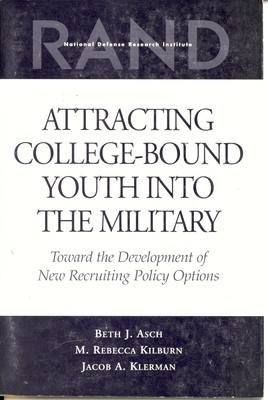
- We will send in 10–14 business days.
- Author: Beth J Asch
- Publisher: RAND Corporation
- ISBN-10: 0833027026
- ISBN-13: 9780833027023
- Format: 15.3 x 22.9 x 0.9 cm, minkšti viršeliai
- Language: English
- SAVE -10% with code: EXTRA
Reviews
Description
Although the military's need for enlisted personnel has declined by almost one-third since the end of the cold war, the armed services are finding it difficult to meet their recruiting goals. Among ongoing changes in the civilian labor market is a strong demand for skilled labor, which has prompted an increasing number of high quality youth to pursue post-secondary education and subsequent civilian employment. Because of this competition for high quality youth, the Department of Defense may want to explore new options for attracting desirable young people into the armed forces. The military, for example, offers a myriad of options for service members to take college courses while in active service. However, the programs do not in fact generate significant increases in educational attainment during time in service. One popular program, the Montgomery GI Bill, enrolls large numbers of individuals, but the vast majority of service members use their benefits after separating from service. Thus, the military does not receive the benefits of a more educated and productive workforce, unless the individuals subsequently join a reserve component. The authors suggest the Department of Defense should consider nontraditional policy options to enhance recruitment of college-bound youth. Recruiters could target more thoroughly students on two-year college campuses, or dropouts from two- or four-year colleges. Options for obtaining some college before military service could be expanded by allowing high school seniors to first attend college, paid for by the military, and then enlist. Or the student might serve in a reserve component while in college and then enter an active component after college. Alternatively, the military could create an entirely new path for combining college and military service by encouraging enlisted veterans to attend college and then reenlist (at a higher pay grade). The most promising alternatives should be evaluated in a national experiment designed to test their effectiveness and cost-effectiveness, similar to the one that led to the creation of the Army College Fund and the Navy College Fund.
EXTRA 10 % discount with code: EXTRA
The promotion ends in 21d.06:21:08
The discount code is valid when purchasing from 10 €. Discounts do not stack.
- Author: Beth J Asch
- Publisher: RAND Corporation
- ISBN-10: 0833027026
- ISBN-13: 9780833027023
- Format: 15.3 x 22.9 x 0.9 cm, minkšti viršeliai
- Language: English English
Although the military's need for enlisted personnel has declined by almost one-third since the end of the cold war, the armed services are finding it difficult to meet their recruiting goals. Among ongoing changes in the civilian labor market is a strong demand for skilled labor, which has prompted an increasing number of high quality youth to pursue post-secondary education and subsequent civilian employment. Because of this competition for high quality youth, the Department of Defense may want to explore new options for attracting desirable young people into the armed forces. The military, for example, offers a myriad of options for service members to take college courses while in active service. However, the programs do not in fact generate significant increases in educational attainment during time in service. One popular program, the Montgomery GI Bill, enrolls large numbers of individuals, but the vast majority of service members use their benefits after separating from service. Thus, the military does not receive the benefits of a more educated and productive workforce, unless the individuals subsequently join a reserve component. The authors suggest the Department of Defense should consider nontraditional policy options to enhance recruitment of college-bound youth. Recruiters could target more thoroughly students on two-year college campuses, or dropouts from two- or four-year colleges. Options for obtaining some college before military service could be expanded by allowing high school seniors to first attend college, paid for by the military, and then enlist. Or the student might serve in a reserve component while in college and then enter an active component after college. Alternatively, the military could create an entirely new path for combining college and military service by encouraging enlisted veterans to attend college and then reenlist (at a higher pay grade). The most promising alternatives should be evaluated in a national experiment designed to test their effectiveness and cost-effectiveness, similar to the one that led to the creation of the Army College Fund and the Navy College Fund.


Reviews